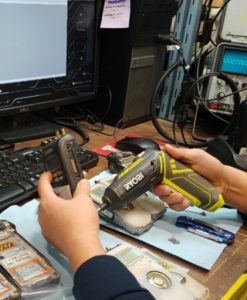Have your handheld or mobile radios reached their end-of-life?
Contact Tridon, and we’ll help you phase them out.
Handheld and mobile radios have a shelf life, just like any other piece of technology. Even with the most diligent repair and maintenance practices, your fleet of radio equipment will eventually become unsupportable. They may work well enough in the short-term, but keeping up with radio repairs and maintenance will become increasingly difficult.
If you know that – or are just curious if – your radios are approaching their end-of-life, Contact Us. One of Tridon’s Account Managers will confirm whether your radio equipment is still supported and help you plan accordingly.
But, if you want more information on the challenges of using radio equipment past its end-of-life, keep reading.
The Manufacturer Won’t Service Them
Once a handheld or mobile radio reaches its end-of-life, manufacturers like Motorola Solutions and Kenwood will no longer repair that model. In fact, ‘end-of-life’ means they aren’t even manufacturing parts for the radio, anymore. They’ve shifted their attention and resources to other products. It also means that the firmware and applications your radio relies on won’t see any additional updates for the same reasons.
In the short-term, this may not be a big deal, especially if your radio equipment is in good condition. But as you move from one project to the next, you’ll find the wear and tear add up pretty quickly and eventually leads to performance issues. When you get to this point, you’ll find that manufacturers won’t be able to do much for you, and local service providers may not, either.
Local Radio Suppliers May Not Be Able to Service Them
When a series of mobile or handheld radios reaches its end-of-life, it impacts local two-way radio suppliers and repair shops, too. They can’t get repair parts for the discontinued model, or replacement radios because the manufacturer isn’t supplying them anymore. There might be some stock left over that they can order for you, but that won’t last for long.
For example: In 2020, Motorola announced that it was discontinuing its XPR 4000 and 6000 series of radios. They aren’t making them anymore, nor are they making parts needed for repairs. This means that Motorola radio suppliers will be relying on whatever is leftover in their inventory to repair customer radios. They may be able to find more from third-party resellers, but that is a short-term solution, at best.
And for you? It means that there’s no guarantee that you can get your radio equipment repaired and you can’t buy replacements in the same model. You and your team could be stuck using the radios in their current state of repair. If the radio doesn’t work at all, it means your team won’t have the communications gear they need to do their jobs safely. And, in work environments where everyone must have a means of communication with them (refineries, mines, etc.), they may not be able to work, at all. That loss of productivity can lead to downtime that seriously derails your project.
You Could Face Significant and Unexpected Expenses
If you don’t plan to phase out your aging radio equipment, you could find yourself forced to do it all at once.
For example, let’s say you shelve your radios at the end of a project, with no plans to use them for a few months. If you don’t have them inspected and repaired before putting them into storage, any problems that exist will go undiagnosed and unaddressed. If your equipment is still supported, you may find yourself in a rush to get them in good shape before you use them again. That can be stressful, but at least the pain is temporary.
But if your radio equipment has reached its end of supported life, then any delay in getting them repaired will leave you scrambling. You may have to go to multiple service shops to get them back in working order. Or you might find yourself with a barely functioning fleet of communications gear.
To keep your project on track, you’ll have to rent radios (possibly on short notice) or even buy a fleet of replacement equipment. Planning ahead would have mitigated these costs and certainly reduced the shock factor of having to pay them.
The news isn’t all bad, though. In fact, if you plan for it, your radio equipment reaching the end of its supported life presents you with some interesting opportunities.
Upgrading at A Discount by Trading In
Manufacturers like Motorola Solutions regularly offer trade-in discounts as a way of encouraging end-users to upgrade to the latest technology. For example, Motorola is currently offering a trade-in discount on the XPR 7580 and other 7000 series radios as a way of encouraging users to upgrade from discontinued models, like the XPR 6000 series. These programs are fairly flexible in terms of the types of radios you can bring in. You could bring a range of different models from different manufacturers and still qualify.
Get in touch with Tridon for more information.
You Can Manage Your Costs
If you plan for your radio equipment’s end-of-life, you can control the costs that come with it. Those plans may include comprehensive inspection and repairs of your entire fleet to extend its useful life. They may, and likely will, include a review of your communications requirements and objectives in the years ahead.
Planning for this will also give you the opportunity to review business practices to determine if renting two-way radios is a more cost-effective strategy than buying. For example, if you rent radios, you aren’t responsible for storing them while they sit idle, or for managing the inventory. Another reason renting might be an attractive option is that the cost of renting covers the repairs that are necessary with regular use.
But maybe the biggest advantage is, quite simply, that you don’t own the radio. That means when they reach their end of life, the challenges and costs of phasing them out will fall on your radio supplier, not you.
Getting Started
Radio manufacturers phase their products out of service for the same reason all technology companies do: they have innovated a better solution to their customers’ needs and maintaining the older models would counter efforts to innovate further. While managing the transition to the next generation of tech can be challenging, the easiest way to navigate it is to plan ahead.
By staying in regular contact with your radio supplier, you can stay ahead of the curve and make these plans well in advance. So, if you’d like to know the status of your radio equipment, or if you’re ready to build a plan around phasing it out, Contact Us. Our Account Managers are here to help.
Tridon is a full solution Telecom Systems Integrator with CSA certification and licensed by APEGA. Our Engineering, Service, and Tower divisions collaborate with customers to build engineered solutions including communications systems design, tower inspections, and co-location, wireless broadband, fiber optic cabling, site security, and two-way radio communication.





